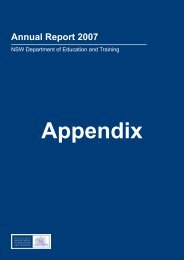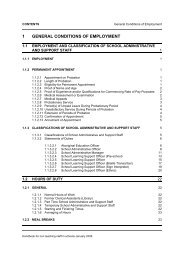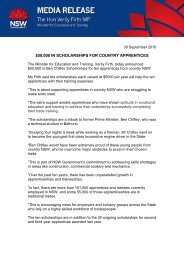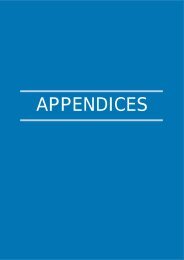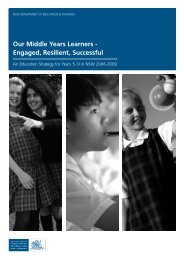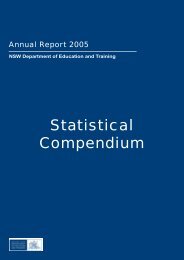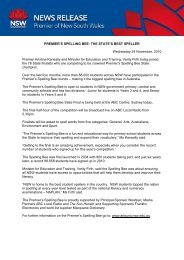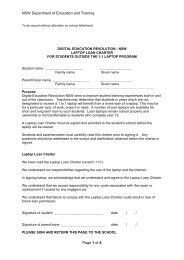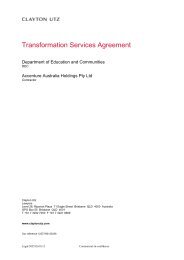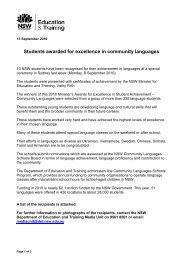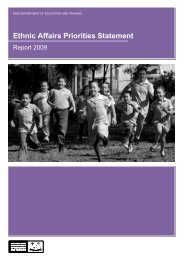01 - Department of Education and Communities - NSW Government
01 - Department of Education and Communities - NSW Government
01 - Department of Education and Communities - NSW Government
You also want an ePaper? Increase the reach of your titles
YUMPU automatically turns print PDFs into web optimized ePapers that Google loves.
GETTING THE FOUNDATION RIGHTExcellence in Personal Development,Health <strong>and</strong> Physical <strong>Education</strong>Botany Public School received a Director-General’s School Achievement Award forits excellent Personal Development,Health <strong>and</strong> Physical <strong>Education</strong> programs.❝The student outcomes in this KLA havebeen achieved through balancedcomprehensive programs that havegenerated much pupil excitement over along period <strong>of</strong> time.❞Participation Rates in ProgramsRelated to the Olympic 2000Schools Strategy1996 1997Pierre de CoubertinAwards 185 214Network <strong>of</strong> FriendshipPrograms 330 369‘Adopt an Athlete’Program 82 96Teacher developmentcourses 23 87620 766School SportThe Sport Policy was revised inlight <strong>of</strong> significant changes thathave occurred since its release in1986. New guidelines will bereleased in Semester 1, 1998.The sport participation program hascontributed to an increase in thequantity <strong>and</strong> quality <strong>of</strong> sportactivities available to studentsthrough:• implementation <strong>of</strong> the ActiveYouth Program as acomponent <strong>of</strong> the SchoolSport 2000 Foundation. Thisprogram assisted schools topromote active <strong>and</strong> healthylifestyles for Years 7-10students• working with externalproviders <strong>of</strong> sport programs,including the <strong>Department</strong> <strong>of</strong>Sport <strong>and</strong> Recreation.The School Sport 2000 Foundationpromoted <strong>and</strong> supported avariety <strong>of</strong> DSE school sportprograms, ranging from elite staterepresentative teams through tograssroots participation. A total <strong>of</strong>141 schools received grants in 1997totalling $156,000. Grants <strong>of</strong> up to$2,000 were allocated to schoolsthroughout <strong>NSW</strong> to implement adiversity <strong>of</strong> fitness <strong>and</strong> healthinitiatives.The <strong>NSW</strong> Primary Schools SportsAssociation (PSSA) programprovides students with theopportunity to compete at threelevels. Throughout the year, the<strong>NSW</strong>PSSA conducted 20 statecarnivals involving more than5000 students. At the completion<strong>of</strong> each <strong>of</strong> these carnivals a<strong>NSW</strong>PSSA team was selected tocompete in the Australian SchoolsSports Council Exchange program.The <strong>NSW</strong>PSSA also conducted 15statewide knockout competitionswhich attracted more than 3500team entries in 1997.The <strong>NSW</strong> Combined High SchoolsSports Association (CHSSA)program provides students with theopportunity to compete in schoolbased knockout competitions, statecarnivals, state championships, allschool matches, Australianchampionships <strong>and</strong> internationalexchanges <strong>and</strong> visits.Over 600 primary schools <strong>and</strong>nearly all central <strong>and</strong> high schoolsparticipate in statewide interschoolsport competitions. Participationin all primary school carnivals<strong>and</strong> knockout events has increased.Participation in competitions forsecondary schools has remainedfairly constant over the past fouryears.Special SwimmingSchemeThe $1.7m Special SwimmingScheme caters for students whoare unable to swim 25 metresconfidently <strong>and</strong> unaided in deepwater. In 1996-97 a total <strong>of</strong> 104,000students from 1150 primaryschools, special schools <strong>and</strong>Intensive Language Centresparticipated in the scheme.A pre <strong>and</strong> post test <strong>of</strong> studentsinvolved in the program revealedthat 80 per cent <strong>of</strong> complete nonswimmersat the beginning <strong>of</strong> thecourse progressed to be able toswim one to five metres by the end<strong>of</strong> the course. Of students in the 11to 20 metres group, 99 per centprogressed beyond 25 metres bythe end <strong>of</strong> the program. Noticeableimprovements were also evident instudents who could swim greaterdistances than five metres at thebeginning <strong>of</strong> the course.The School Sport Unit worked withAUSTSWIM (<strong>NSW</strong>) to developtraining initiatives for classroomteachers who assist in theswimming scheme. These programswill be in place for the 1999 season.26 DSE Annual Report 1997




